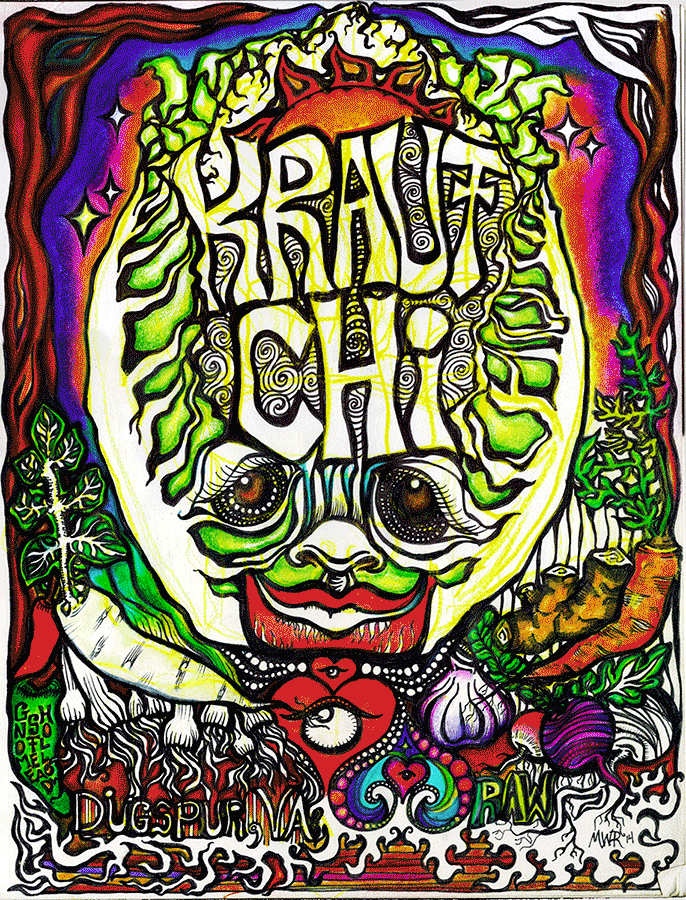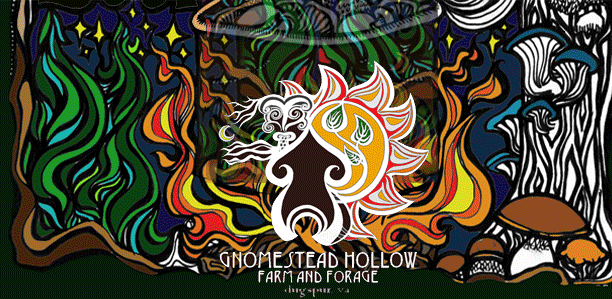Our Gnomemade Krauts
That Gnomemade taste you Gnowe n' Love
Here at Ye Olde Gnomeplace, we craft all of our Krauts and Kimchi using local ingredients from our farm and from family farms practicing sustainable agriculture in the Blue Ridge Mountains and foothill regions of Virgina and North Carolina. We believe the environmental conditions, including the temperature, soil, climate, and cultivation practices, form the foundation for creating the character of our krauts. By incorporating the mushroom compost from our farm into our garden beds, we are able to build soil fertility and beautiful tilth while helping to close the loop on off-farm inputs. Solid fermentation of organic matter through this fungal alchemy helps produce some of the finest fermented microbe food (and soil) in the land! We also produce our vegetable ferments using ye Olde World methods - creating small batches o' salt-brined, probiotic-rich gudtness in 5-10 gallon ceramic crocks. Harnessing the power of beneficial, wild fermentation bacteria , we are able to craft delicious variations of vegetable ferments from cultures all over the world, using vegetables and herbs grown right here in the Blue Ridge Mountains. We are certified Appalachian Grown, and we are proud to be a part of the Appalachian Sustainable Agriculture Project's mission, promoting greater access to fresher, better tasting, and healthier food, while helping to protect the rural heritage and natural beauty of the mountains by preserving farmland and encouraging sustainable, environmentally-friendly agricultural practices. Bio-regional bounty.. check! Grab a jar of kraut or kimchi and taste a flavor of the fermented rainbow!





The Ballad of Lactobacillus (and other ecological allies)
Fermentation microbes are an invaluable (and often under-appreciated) natural resource available to people all over the world. These microorganisms have inevitably helped mankind progress from early hunter-gatherer, through gnomadic pastoralism, to the dawn of subsistence agriculture and subsequent human civilization. In fact, all human cultures have relied on these ubiquitous microbial allies to survive and thrive through the cold, hard winters and the hot drought-ridden summers. Furthermore, food fermentation has allowed humans to capture the bounty of the growing and harvest seasons, and to enhance the nutrition and increase shelf-life of this food to be used in times of greater scarcity (such as winter and drought.) In times of abundance and surplus, the fermentation of grains, vegetables, fish and meats continue to create and enhance some of the most delicious and widely-acclaimed culinary and libatious experiences still eaten, imbibed and enjoyed on the planet, today. Put simply, these microorganisms (bacteria and yeasts) produce lactic acid and alcohol, and they have provided the catalyst for food fermetation since day 1. Thankfully, many of these wild fermentation microbes permeate the land, water and air of every ecosystem on Earth; however, there are so many factors effecting fermentation across the planet, that there can be (almost) no 'absolutism' in fermentation- only experimentation! Humans are not necessarily the "prime movers" in creating this microbial milleu, but we have enjoyed playing an integral role in helping to color the flavor. This fermentation ecosystem can be represented by the same parallel ecological processes which are evident in larger ecosystems. Although the magnitude of continental ecosystems can be hard to conceptualize, fermentation vessels provide a unique opportunity for understanding ecological processes on a microbiological scale (within the confines of the crock!) They are able to help illustrate the effects of climate and temperature on microbial makeup, ecological succession, biodiversity, population dynamics, organization and partition of resources, disruption and equilibrium cycles created through successive waves of microbial activity, relationships, seasonal-flava profiles, etc. (Gnome'sayin'?)
Historically, fermentation yeast and bacteria have either been utilized from the ambient environment, or they have been carefully preserved and maintained in cultures collected by humans over time, across land and sea. As "gnomies of the microbiomies," we work with a wide variety of beneficial fungi and bacteria cultures to create fermentation ecosystems that benefit human ecology by improving nutrition and health for people and for the planet. It's a hard-crock life, for us..
Learn more ::: Fungi and Bacteria: A Tale of Two Kingdoms::::>>>






Kraut for health
Did you know that bacteria outnumber cells in our body by a ratio of 10:1? That's right, we are made up of microbes, and your gut is Microbial HQ.
According to the African Journal of Science and Research (AJSR), “Healthy colons of humans contain some beneficial bacteria which feed on digestive wastes, thereby producing lactic acid. Without these beneficial bacteria, the digestive tracts become a thriving zone for pathogenic bacteria and yeasts, resulting in candidiasis. However, it is suggested that the consumption of lacto-fermented sauerkraut could help re-establish lactobacilli.”
"In Europe the principle lacto-fermented food is sauerkraut. Described in Roman texts, it was prized for both for its delicious taste as well as its medicinal properties. Cucumbers, beets and turnips are also traditional foods for lacto-fermentation. The peoples of Japan, China and Korea make pickled preparations of cabbage, turnip, eggplant, cucumber, onion, squash and carrot. Korean kimchi, for example, is a lacto-fermented condiment of cabbage with other vegetables and seasonings that is eaten on a daily basis and no Japanese meal is complete without a portion of pickled vegetable."
~"Lacto-Fermentation." Sally Fallon.
Gnomemade Krauts


Throughout the growing season, we will be releasing a variety of farm and forest-fresh Seasonal Flavas! Beginning with a Ramp-Nettle Kraut and Spicy Ramp Kimchi in the spring, our Seasonal Flava krauts feature a variety of nutrient-dense, wildcrafted native plants from our beautiful, biodiverse hardwood mountain forests and meadows. Additionally, we use the seasonal farm abundance of our Blue Ridge bioregion to craft our delicious, probiotic-rich krauts, kimchi and pickles. Fermenting the bounty of our local farms and native forests allows us to highlight, biologically-enrich and ambiently enliven the incredible cornucopia of food growing and being produced in our beautiful mountain countryside.

Cobblestone Chow Chow
Spicy Ramp Kimchi
You Can't Escape the Allium
Pao-Cai
Seasonal Flavas!


Ramp-Nettle Kraut
Ramp Kakkdugi
Spicy Gnomadic Roots
Salt N' Pepper
Sour Electric Beets




Golden Curry Kraut
Ingredients: green cabbage, fresh turmeric root, cumin
and mustard seeds, Pink Hawaiian Salt
Naturally sweet and savory, and embedded with rays of golden summer sunshine, this kraut is undeniably divine. The combination of fresh turmeric and cumin offer a curry kick that will make you coo, and coo again! With the healing, anti-infalmmatory properties of fresh turmeric in addition to the power of fermentation, this kraut packs one powerful probiotic punch! Build up your gut and enjoy the potent, delicious flavas of east meets SW (VA)!
Recipe Ideas
Mash with an avocado! Top a warm soup--white bean-to-dal-to-split pea, this kraut is super versatile! Sprinkle into salsa, guacamole, or eat with a hearty, crunchy, crusty piece of rye toast. The possibilties are endless.....YUM.



Royal Curtido
Ingredients: Onions, Carrots, Cabbage, Oregano, Red Pepper Flakes, Pink Hawaiian Sea Salt
This El Salvadorian Kraut-Chi is a delcious, savory herbacious Ode to the Onion! Loaded with carrots and onions, this ferment takes pumps up any delectable dish! It makes a great addition to salsas and guacamole, and takes simple rice and bean dishes to another plane of gnomonic expansion. Throw it on an egg with a little cracked black pepper, and you'll see why this kraut-chi is a Gnomestead Staple!





Korean Style Kimchi
Ingredients: napa cabbage, daikon radishes, bok choy, green onions, organic chickpea miso, ginger, garlic, korean red pepper, Pink Hawaiian Salt
Recipe Ideas
Top with a fried or poached egg and let the yolk run all over! Add a spoonful or two to your favorite stir fry or a bowl of steaming rice and give your veggies an enzymatic kick!
Add to guacamole! SERIOUSLY. Try it!!! Dice and fold into your favorite guac recipe... you'll never go back!



Sauerruben
Ingredients: Turnips, Cabbage, Caraway Seeds, Pink Hawaiian Sea Salt
Recipe Ideas
This Old World favorite makes a delicious addition to sandwiches, salads, and most spicy foods! We endearingly call it SauerRubus, after its biggest fan, Rubus Brambleberry. Try the fermented Glory of Ye' Olde Earth and remember the days of savory yore!!!
Sweet globe turnips, green cabbage and caraway coalesce in this exquisite classic to create a rye kraut of gnomic proportion. Ye Olde caraway Sauerruben is guarenteed to Turnip the Tastebuds!




Fungi and Bacteria:
A Tale of Two Kingdoms
Our vegetables benefit from a fermentation ecosystem long before they reach our crocks. Agricultural byproducts containing lignin and cellulose are rapidly decomposed using several species of fungi grown on our mushroom farm. These fungi secrete powerful digestive enzymes to break down cell structure and release nutrients. Through this process of solid fermentation, a procession of biologically diverse beneficial organisms emerge and go to work, ultimately creating a microbially-rich, nutritive environment for healthy plants to thrive. The same ecological concept can be illustrated and applied to human gut ecology with the addition of fermented foods containing lactic acid bacteria, such as kraut and kimchi ~
Living organisms cover the Earth's surface, just as wild fermentation microbes can be found on the surface of living organisms.
The intentional use of fermented foods by people demonstrates how all biological processes are inextricably linked through ecological processes.
The examples of cultures which last the longest may be those that emulate the nature of ecosystems.









© 2018 by Gnomestead Hollow Farm and Forage.



